Sadly, I’m no aristocrat and this isn’t the 18th century, but I did go to Italy in search of art and architecture. Part 1: Florence & Arezzo.

I’ve been covering art and architecture recently, so an immersive visit to Italy seemed like a good idea. I wanted to see for myself the palaces, the churches, the frescoes, the paintings (or whatever remained of them) which had such an influence on Western art. This concept is nothing new, of course. The idea of a Grand Tour goes back at least to the 17th century when it was standard practice among the more enlightened members of the high nobility to spend a few years traveling through Italy to study – or pretend to – the classical world through its ruins.
Unfortunately I don’t sit on a dynastic fortune, so my Grand Tour was compressed into an intensive three-months period which took me from Venice to Rome, with a dozen cities and more than a hundred museums in between. What follows isn’t a collection of amusing travel stories – sorry! – but my attempt at making sense of the artworks I've seen. I included specific recommendations for museums and architecture with a map in case you're inspired, and also a short food and wine summary of the regions I visited. Part 1: Florence & Arezzo.
Florence in a Paragraph
Florence has at least two strong claims for itself. One, it was the birthplace of the Renaissance in about 1400 and became the greatest center of the arts in Italy for the next one hundred years. Two, Italian language today comes from the Tuscan vernacular, meaning that people in Florence speak its purest form. These reasons might explain why the Florentine are known to be looking down at their noses at outsiders, even those from Italy. Or perhaps it has to do with the number of tourists that swarm this city at all times of the year. On my trip, only Venice was more crowded (#3: Rome, #4: Verona, #5: Bologna).
Tuscan Food & Wine
Traditional Tuscan food is simple, robust and unfussy. Beans from the New World became so popular that Tuscans are mocked as "bean eaters" to this day. Many restaurants serve ribollita (reboiled), a leftover hearty peasant dish of vegetables and sometimes beef. Tuscany produces the finest olive oil in Italy and is the only region with a steak culture – the Florentine steak is a T-bone, a thick cut of tender Chianina beef grilled over charcoal. At food carts in Florence, I’ve had delicious lampredotto: a cow’s stomach cooked into tender submission and served chopped up in a sandwich slicked with pesto and broth.
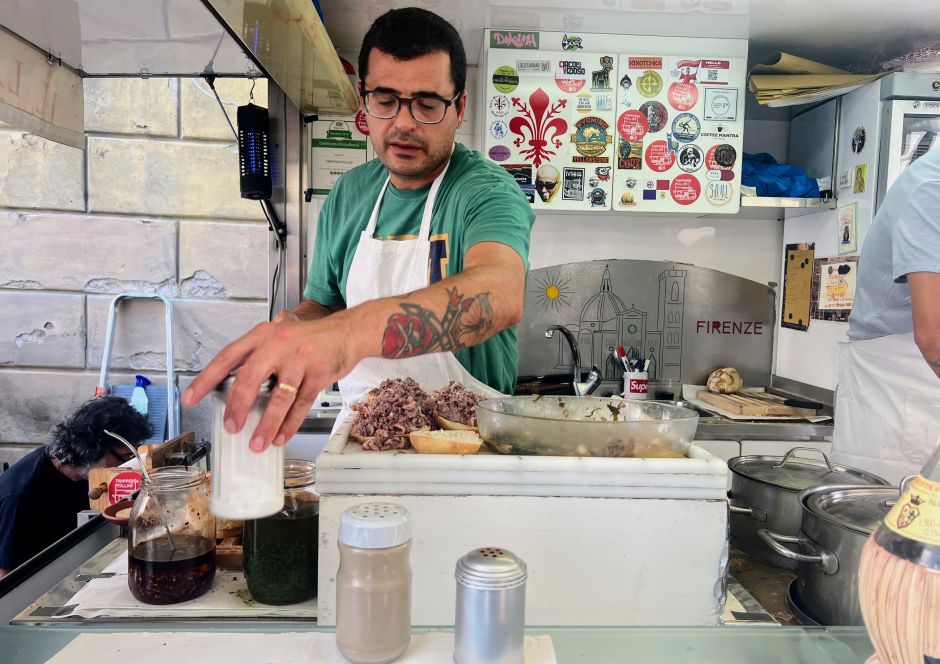
Tuscany’s wines are the best in Italy beside those of Piedmont and the Veneto. The dominant grape is the Sangiovese, which makes at least three excellent wines: the Chianti Classico, the Vino Nobile di Montepulciano (different from the Montepulciano grape), and the Brunello di Montalcino. Locals have nudged me to Bolgheri, a newer region that makes reds from French grape varieties, which is arguably less interesting for a visitor.
Only Highs at the Uffizi
Uffizi, the sprawling museum along the Arno River whose countless rooms once served as offices for the Medici court. It's the best in Italy, if not the whole world (former Medici artpieces, naturally). Entry was an ordeal, the halls uncomfortably packed with phone-wielding tourists like me but my spirits revived when I reached the first hall, titled: Cimabue & Giotto.
One masterpiece appeared after the next, starting with a 13th-century Duccio and ending three hours later with Caravaggio’s Bacchus. The experience is completely overwhelming. After a while, I grew so numb to these heavyweights that by the time I reached Titian’s Venus of Urbino it had no shock-effect on me. (A nice thing about smaller museums is they have fewer hits that can actually be savored.)
The Uffizi is a giant lesson in the history of painting, from the Gothic to the early Baroque (the full chapter on the Baroque is written in the churches of Rome). I was most taken by Michelangelo’s one surviving panel painting, the so-called Doni Tondo (1505-1507), showing the Holy Family with Saint John the Baptist and five nudes in the background. Where did his polished, bright colors and sculptural-muscular figures come from? A mystery. The Uffizi is good at pointing out influences, but Michelangelo seems to have come out of nowhere. Raphael’s works sharing the hall are from a different world (later, in Rome, he too fell under Michelangelo's sway).
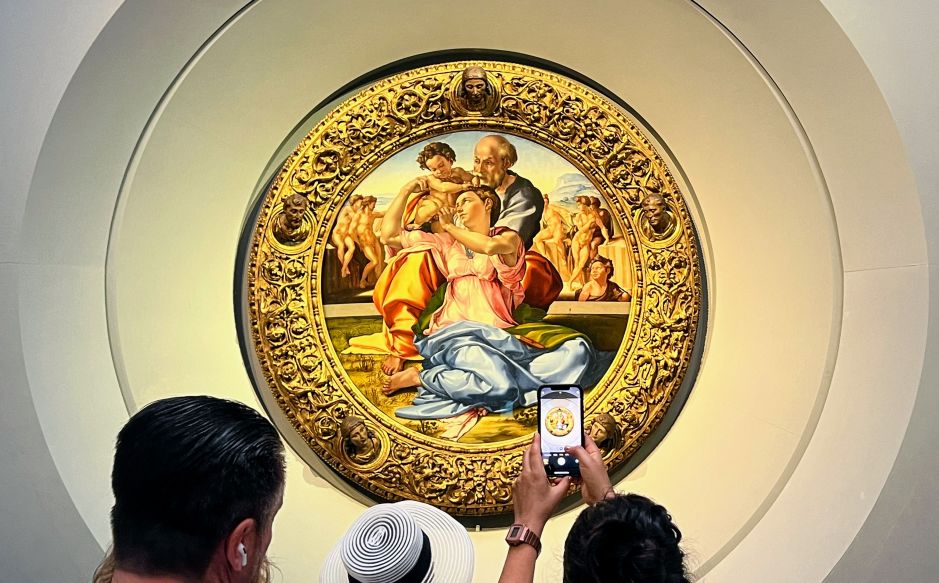
The other that knocked me off my feet was Leonardo’s Annunciation from the 1470s. It confirmed to me that Leonardo really could do anything in painting – spatial depth, anatomy, movement, and color. Apart from those already mentioned, I left the Uffizi with renewed appreciation for Cimabue, Giotto, Simone Martini, Gentile da Fabriano, Masaccio, Paolo Uccello, Fra Filippo, Piero della Francesca, Sandro Botticelli, Luca Signorelli, Pietro Perugino, Antonio da Correggio, Parmigianino, Pontormo, Rosso Fiorentino, Bronzino, Artemisia Gentileschi, Gerrit van Honthorst, and Rembrandt.
Florence's Two Dominican Monks
Perhaps the most famous – and charming – version of Gabriel Archangel’s message to the Madonna is located in Florence’s San Marco Convent, made by the Dominican friar who frescoed the building: Fra Angelico (Beato Angelico in Italian). Today, the complex is an unfrequented museum centered on Fra Angelico’s paintings; it’s fascinating to track his evolution from Gothic to the early Renaissance over the course of twenty years (1430s to 1450s).
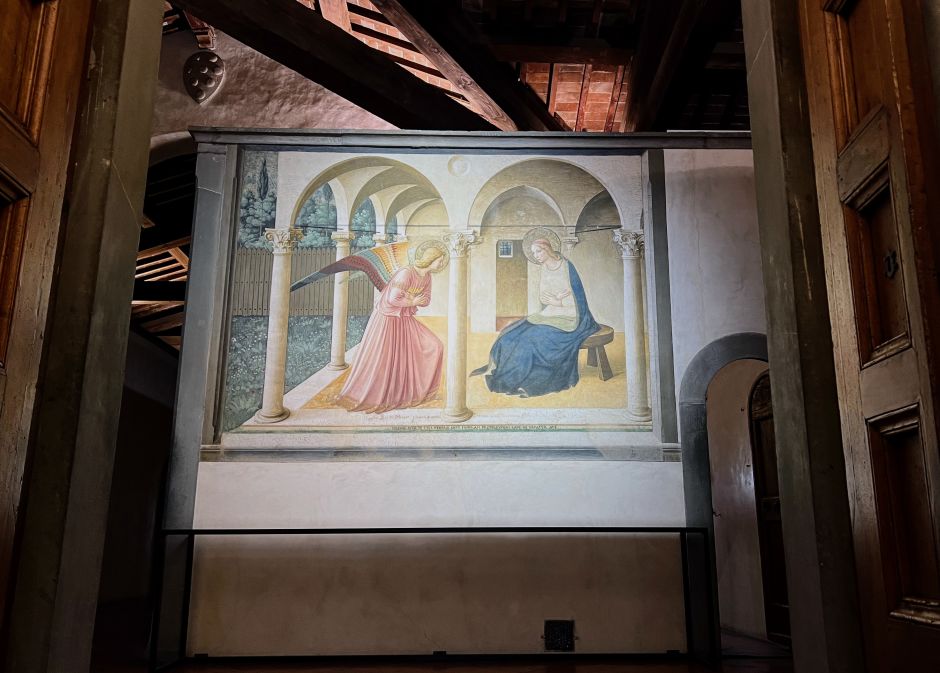
Another famous Dominican monk who lived in this convent: Girolamo Savonarola. Less known for delicate art than for fiery speeches against the morals of his day, which earned him in 1498 a spot on the gallows placed outside Palazzo Vecchio.
Bronzino's Woman (and Men)
Bronzino (1503-1572) is to Florence what Tintoretto is to Venice. They were each among the very best in the mid-16th century, painting in that strangely exaggerated – and addictive – style known as Mannerism. Tintoretto was heavy-handed, dark, fast and loose. Bronzino: precise, luminous, playful, distant. (The Uffizi has an entire hall dedicated to Bronzino-portraits.)
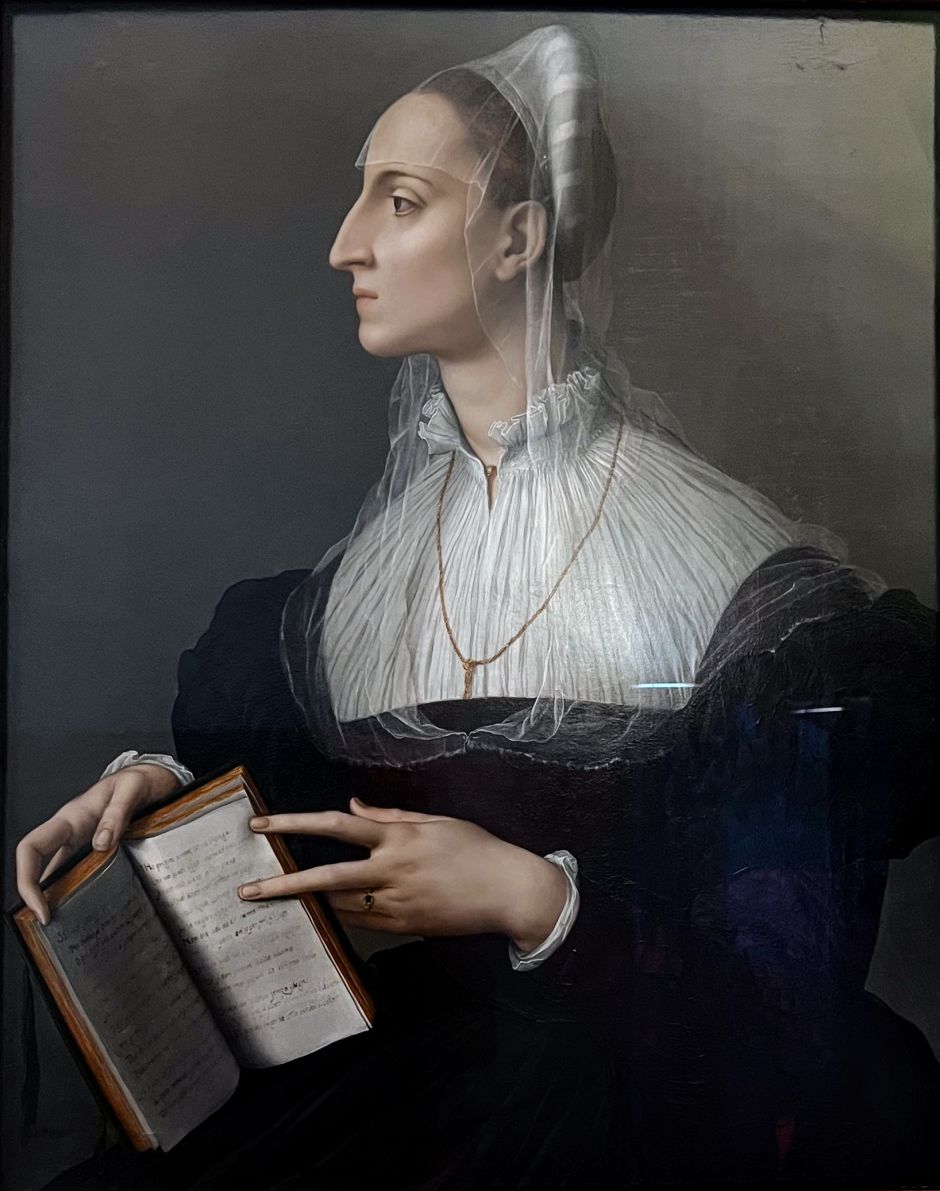
It was in a back room of the Palazzo Vecchio that I stumbled into Bronzino’s portrait of his friend, the female poet Laura Battiferri. I knew of the painting but didn’t know it would be here. I think it’s Bronzino’s greatest work. Laura looks exceedingly elegant and formidably intelligent, and that oversized aquiline nose lends her an unforgettable look. She’s reading a sonnet by Petrarch, which was Bronzino’s brilliant way of indicating her profession and his own relationship to her, which remained platonic (as between Petrarch and his Laura).
The famous art historian Bernard Berenson (1865-1959) thought Bronzino was too fond of painting male nudes (Bronzino was gay). This was evidenced, Berenson argued, by the lewd figures on his Martyrdom of Saint Lawrence (San Lorenzo church) and on his Christ's Descent into Limbo (Santa Croce church). Was Berenson right? You have to decide for yourself, of course. All I can say is that both paintings are spectacular.
Palazzo Pitti & Palatine Gallery
The Palazzo Pitti is the fanciest place in Florence. Built for the Pitti family, it was inhabited by the Medicis, then the Habsburgs took over in 1737 and kept it until Italy’s unification in 1860. At that point it became the residence of King Victor Emmanuel II for the few years when Florence was the capital. The early-Renaissance building with characteristic rustication – the exterior was designed in 1458 with later additions – is currently home to several museums of which the Palatine Gallery is most important.
The Palatine Gallery can’t rival the Uffizi, but the collection is one of the greatest in Europe (mainly Medici and Habsburg possessions). The halls are crowded with paintings in the style of the 17th century so it’s easy to miss the masterpieces with no wall texts to boot. Raphael and Titian best-ofs are aplenty. Here hangs the amazing portrait of Titian’s scandalous friend, the poet and occasional pornographic writer, Pietro Aretino, one of Titian’s Penitent Magdalenes, and his famously recondite painting titled Concert. Upstairs, the Gallery of Modern art is a survey of 19th century Italian paintings (many by the Hungarian-Italian Markó family).
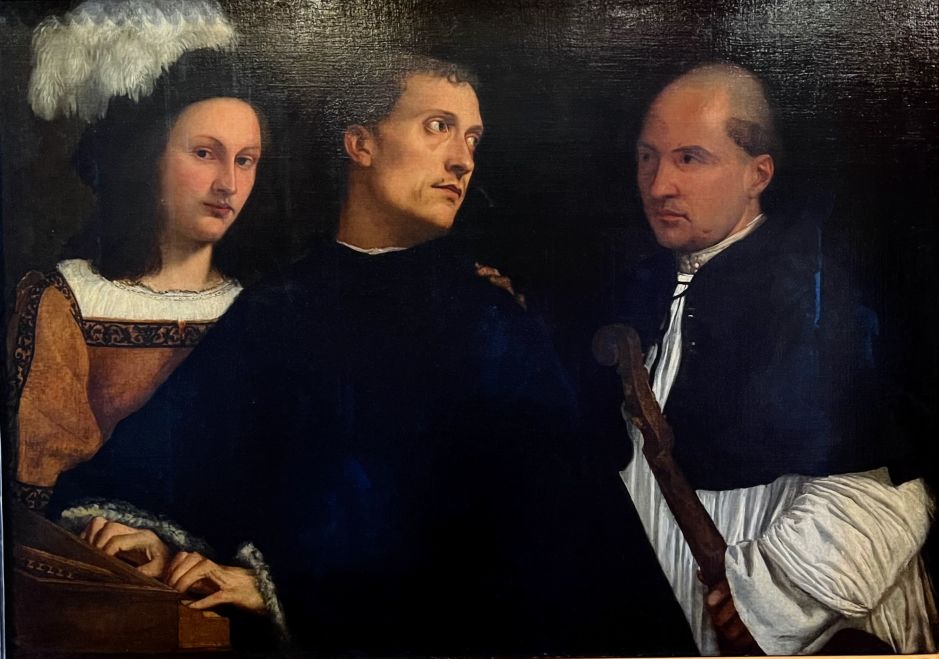
Brunelleschi Epiphany at the San Lorenzo Church
There’s no better place than Florence for early-Renaissance architecture and no better person to start with than Filippo Brunnelleshi (1377-1446), the father of it all. It was in the San Lorenzo, the “in-house” church of the Medici, located across from their family palazzo (Medici-Riccardi), that Brunelleschi finally clicked with me. I used to think of his airy interiors as too Gothic and too free-flowing, but I was hypnotized by the San Lorenzo’s beautiful cohesion. It’s as if every arch, every pilaster, every barrel vault, and every painting belongs exactly where it is. It's a locked system. Nothing added to or subtracted from it would be an improvement.
Brunelleschi’s buildings don’t have the forbidding appearance and heavy masses of Leon Battista Alberti’s churches – those in Mantua, for example – and they’re free from the lively surface treatments of the high-Renaissance that Michelangelo, Giulio Romano, and Andrea Palladio perfected by the mid-1500s. Brunelleschi is simpler and gentler. Perhaps even a bit austere. But he creates beautiful tension between the white stuccoed walls and the gray pietra serena stones.
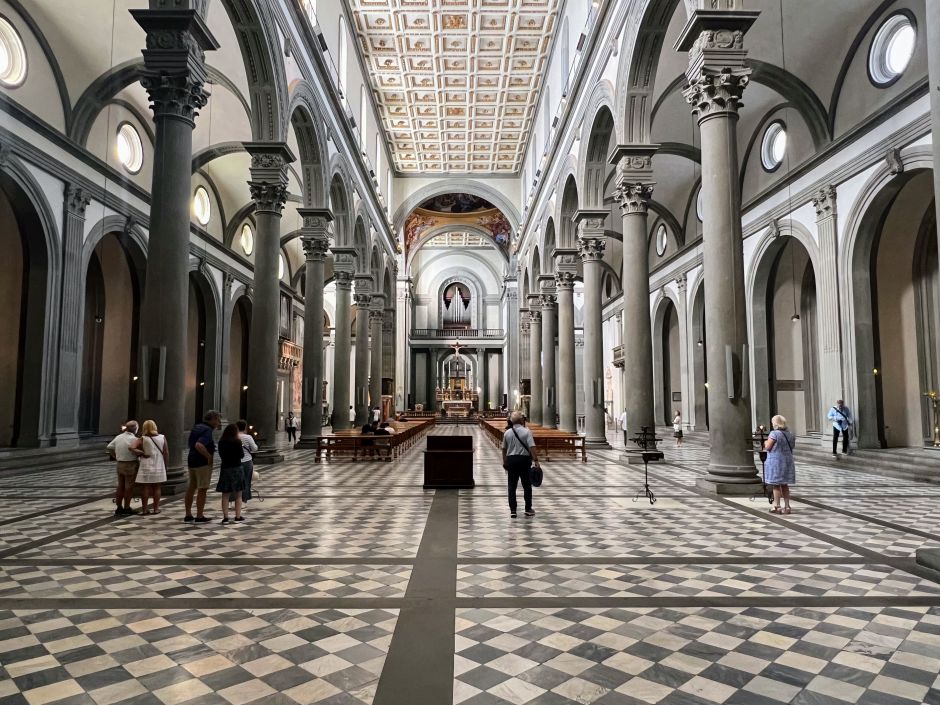
The San Miniato church on the highest point of Florence doesn’t just offer panoramic views but this 11th-century building has remarkable similarities to Brunelleschi’s churches. A reminder that both the Romanesque and Brunelleschi's Renaissance are rooted in the ancient Roman basilica design.
In Florence, more Brunelleschi Brilliance can be had at the Pazzi Chapel (part of Santa Croce church), the Hospital of Innocence (don't miss the cute babies on the terracotta relief medallions), the Santo Spirito church, and of course there's the giant dome of Florence’s Duomo. “A structure so great, rising above the skies, large enough to shelter all the people of Tuscany in its shadow,“ wrote Alberti.
Donatello & Michelangelo in Florence
The San Lorenzo has two elaborate bronze pulpits by Donatello (1386-1466), but his brilliance opens up fully at two nearby sculpture museums, the Opera del Duomo and the Bargello. Donatello’s range is astounding, from the disturbingly expressive Prophet Habakkuk and the Penitent Magdalene, to classical takes on Saint George and David. With apparent ease, he could handle different materials (marble, bronze, wood), sometimes combining them with gold leaf to irresistible effect, as with Gabriel’s Annunciation at the Santa Croce church.
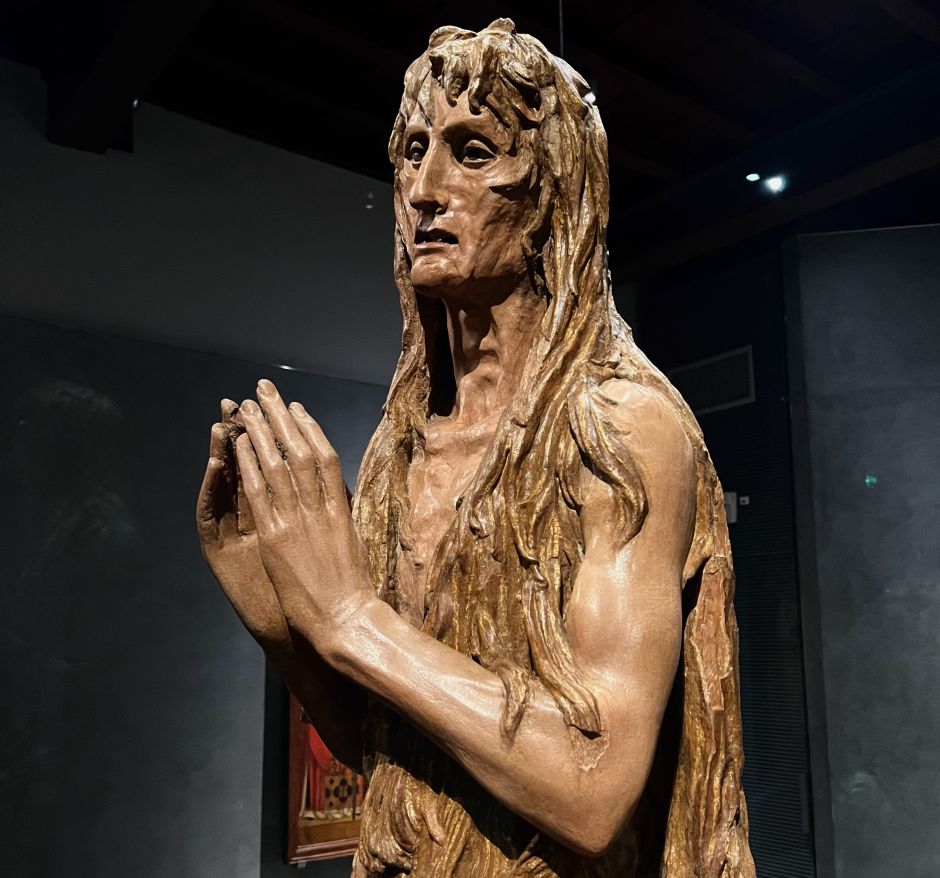
The Bargello is probably the best sculpture museum in Italy, crowded with masterpieces by Lorenzo Ghiberti (The Sacrifice of Isaac), Andrea del Verrocchio (David), Michelangelo (Bacchus), Benvenuto Cellini (Cosimo I de' Medici), Giambologna (Flying Mercury), and Gian Lorenzo Bernini (Costanza Bonarelli). A walk through the halls shows that by the 15th century sculptors completely mastered the human anatomy. There was nothing, it seems, they couldn’t do. Why is then Michelangelo (1475-1564), who came later, often considered the greatest?
I think because Michelangelo was more passionate. After proving himself with such early masterpieces as the Saint Peter's Pietà, sculpture for him was no longer about perfecting human bodies or following classical forms. It was about conveying life in all of its horrors and joys, strengths and weaknesses. Michelangelo was deeply religious and he wanted to express the power of God through his works. He always looked for the presence of the spiritual.
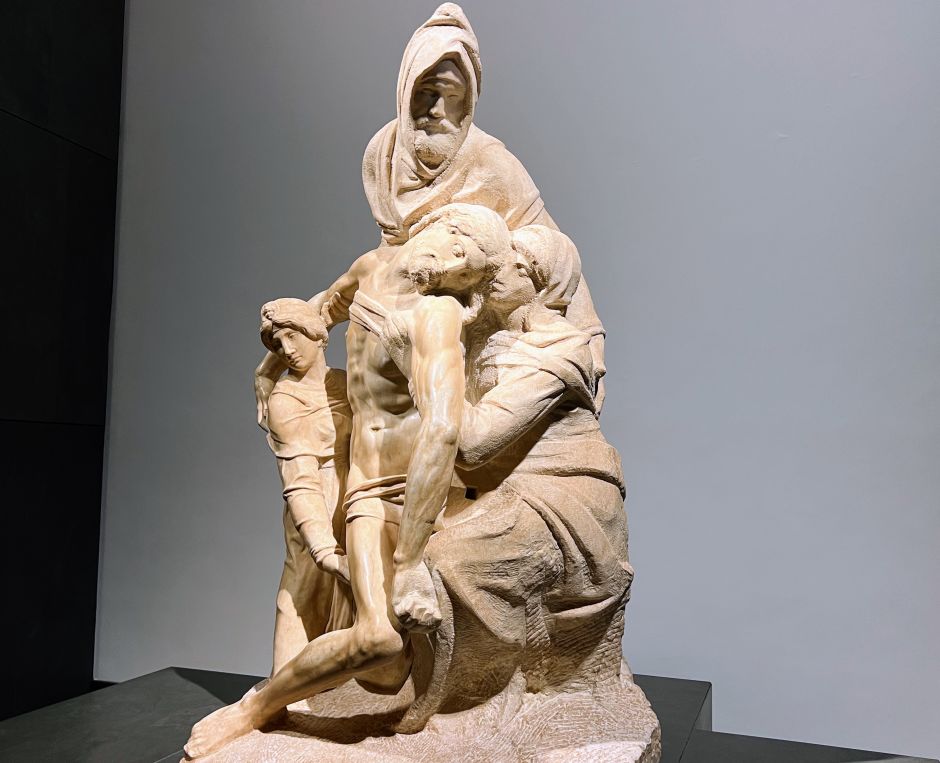
Michelangelo's Florence
Michelangelo was a Florentine through and through but lived the last thirty years of his life, after 1534, in Rome. Disappointment about the Medici tyranny in Florence and big papal commissions for painting and architecture drew him to Rome, including The Last Judgment for the Sistine Chapel and, most importantly, the building of the new Saint Peter's Basilica in the Vatican.
In Florence, Michelangelo's most important works are inside the San Lorenzo complex: He designed both the Medici Chapel and the Laurentian Library in the late 1520s, about a hundred years after Brunelleschi's plans for the San Lorenzo church itself. The chapel is famous for its pairs of marble figures resting atop the Medici tombs: Dawn and Dusk on one side, Night and Day on the other, symbolizing the passage of time. They’re enormous in size and not what most people would call elegant. My first reaction was unease; that great head of the Day is frighteningly enigmatic but fitting for a funerary monument.
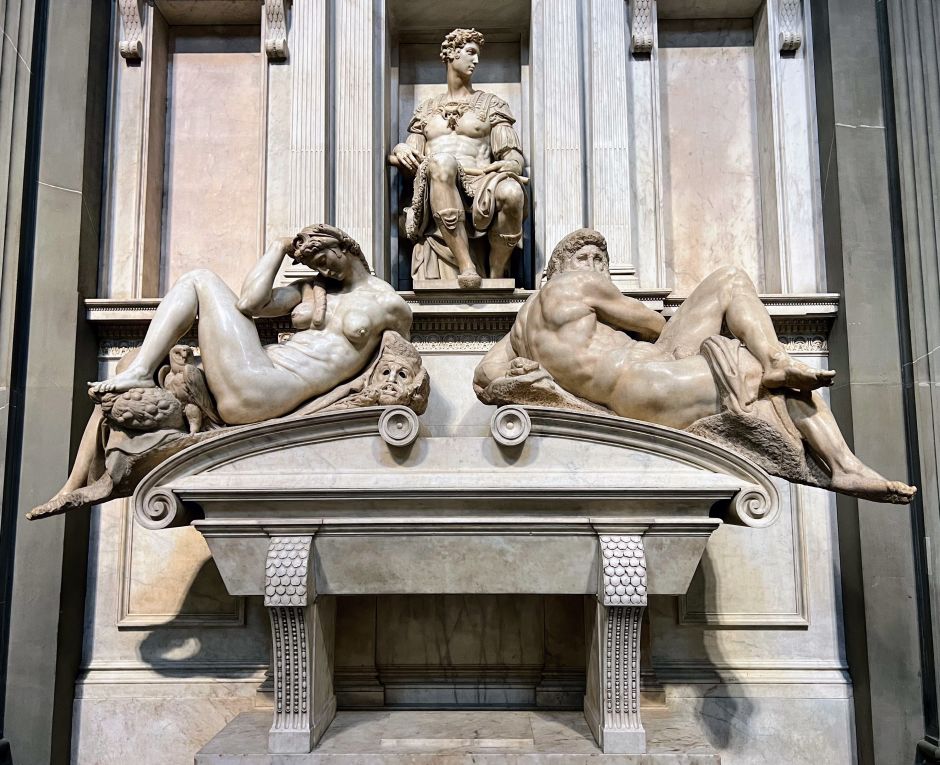
The chapel’s interior, also by Michelangelo, shows his break with early-Renaissance architectural conventions. While the chapel’s lower level has typical 15th-century tabernacles and columns, higher up the pediments are suddenly broken at the bottom, jutting out at the top, and the pilasters come without capitals. He moved to a freer and more expressive, sculptural style, away from the sober geometries established by Brunelleschi and developed by Bramante.
Michelangelo dialed up this idiosyncratic vocabulary at the Laurentian library, made for the Medici’s book collection. A very kind librarian allowed me a glimpse and I was giddy with excitement because I had read so much about the place. The library's vestibule is unusually tall and crowded with robust sculptural forms: double-columns, pilasters, volutes, window pediments, all of them oversized as are Michelangelo’s figures in sculpture and painting. Many serve no functional purpose (the volutes don’t support anything) or have unusual shapes (tapered columns).
The vestibule feels compressed and dark, but also incredibly grand. It’s a special space without being especially heart-warming. Then I mounted those curvilinear stairs that seemed to be flowing down on me and suddenly a calm and proportional and sun-filled reading hall emerged before me. The opposite of the vestibule. What was Michelangelo thinking? Perhaps the vestibule is a metaphor for the hard work required before one reaches Mount Olympus, represented by the reading hall? Who knows. Today, the vestibule is a famous example of Mannerist architecture that ushered in the high-Renaissance with lasting impact also on the Baroque.
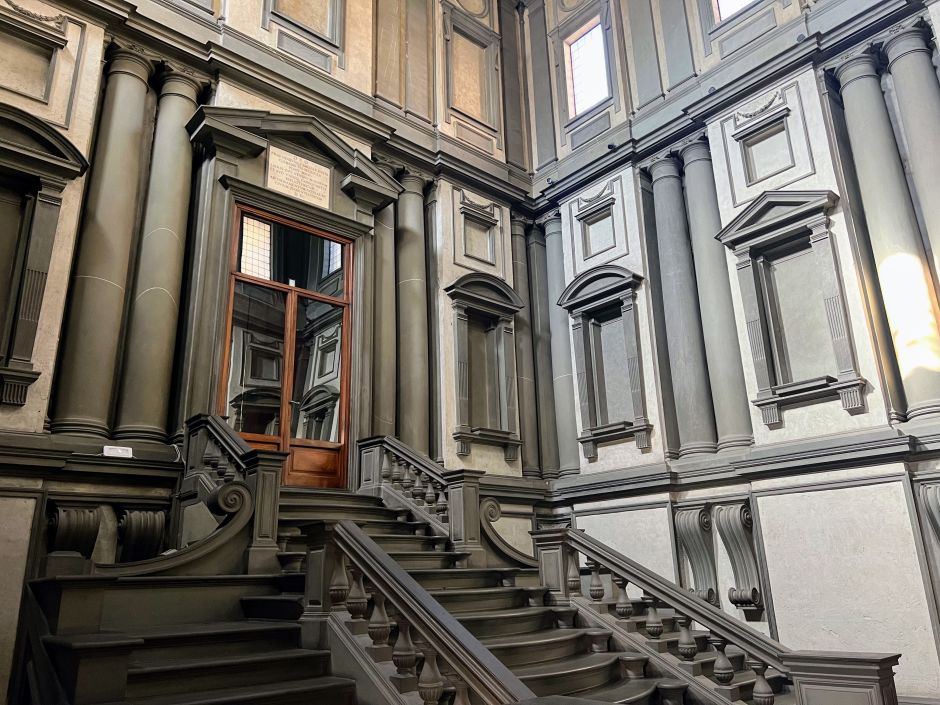
The Casa Buonarotti is the building where Michelangelo’s nephew and his descendents lived for generations and collected the works of their famous ancestor. The highlights are two incredible marble reliefs of the teenage Michelangelo and some of his drawings and models, including the facade plan for the San Lorenzo from 1517 (never built). There's a bombastic hall meant to glorify the life of Michelangelo. It's covered in 17th-century paintings showing the master's encounters with various popes and kings.
A Lesson in Gothic vs. Renaissance
The Santa Maria Novella church, right by Florence's train station, provides a pointed lesson in the differences between Gothic and Renaissance painting. The Spanish Chapel’s ribbed vaults and walls are covered by an amazing fresco cycle of Andrea di Bonaiuto from 1365-1367. The busy scenes celebrating the Dominican order are piled atop one another, attempts at spatial depth are clumsy, sizes and proportions arbitrary, the figures frozen in time, and the painted buildings Gothic in style.
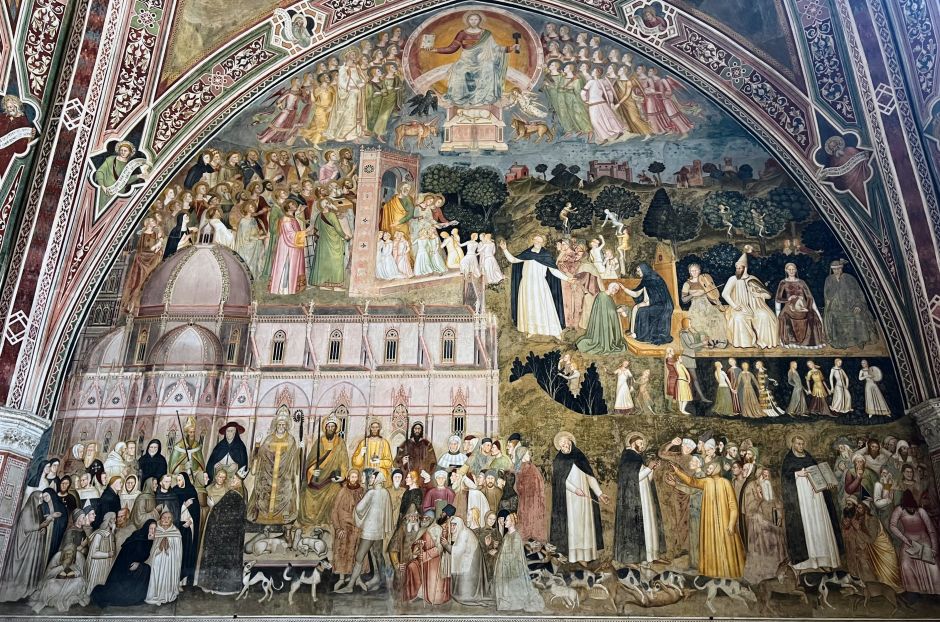
The counterpoint, just steps away, is the Holy Trinity fresco of Masaccio, made in 1425 and regarded as one of the landmarks of the early Renaissance. Masaccio’s figures are more life-like and plastic than Bonaiuto’s, but the big difference is his rendition of space and architectural forms. That striking coffered ceiling behind the crucified Christ evokes the great buildings of ancient Rome, perhaps the Basilica of Maxentius, that so fascinated early-Renaissance painters such as Masaccio, Andrea Mantegna, and Piero della Francesca.
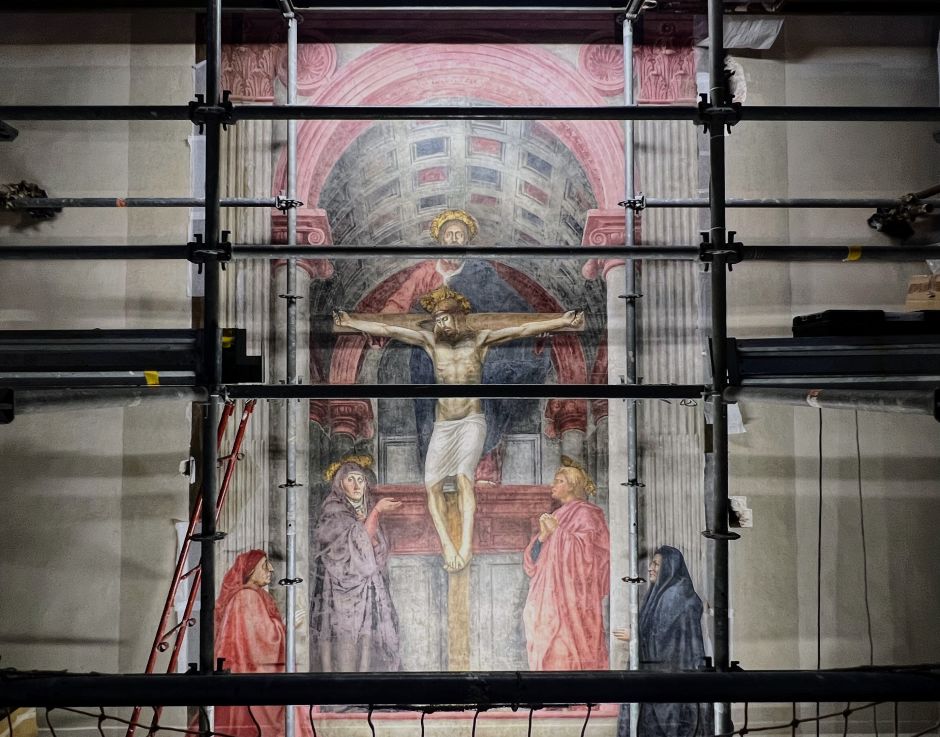
The Florentine Palazzo & Otto Wagner
Around the 1450s, wealthy Florentine families started to build a new type of residential palace for themselves. No longer a fortress, these buildings had plenty of windows and featured classical architectural details. The heavy stone rustication of the ground floor would yield to softer surface treatment on the upper levels and terminate in a dramatically projecting cornice.

To avoid the overt display of wealth, they reserved the more ostentatious elements for the inside, such as the airy open courtyards supported on Corinthian columns (like the Roman peristyle), the great halls, the Roman sculpture collections, and the frescoed and coffered ceilings. Apart from Michelozzo’s Palazzo Medici-Riccardi, which can be visited, other examples include the Palazzo Strozzi, the Palazzo Rucellai, and the Palazzo Gondi (the mullioned arcade windows have to be a remnant of the Gothic period).
These buildings had a huge influence across Europe during the 19th-century Renaissance Revival period, especially in Budapest and Vienna. Both of these cities are teeming today with smaller versions of Renaissance palazzos (by the early 20th century, they were ridiculed for being mindless imitations using cheap materials). In Vienna, I’m usually able to quickly spot Otto Wagner’s buildings because they stand out in quality and because of their characteristically projecting cornice. Something I had thought of as a Wagnerian trademark until my Florence visit. Oh well. I still love Wagner.
Florence - Hungary Relations
For a short period, Hungary wasn’t so far behind the Italian Renaissance. Matthias Corvinus (1443-1490), King of Hungary, whose wife Beatrice was the daughter of the King of Naples, hired the leading artists of Italy to work at the royal palaces in Buda and Visegrád. One of them, Giorgio Vasari tells us, was Benedetto da Maiano, who earned fame for designing the Palazzo Strozzi in Florence. It’s unclear what da Maiano did or didn’t do in Hungary and little of it would remain anyway due to the Ottoman occupation that soon brought an end to this golden era. But not before King Matthias had his portrait painted by Andrea Mantegna; sadly, only a copy survives.
Piero della Francesca in Arezzo
One of the oldest cities in Italy, Arezzo has been continuously around since its Etruscan beginnings. It’s only an hour away from Florence by train and I visited it because of Piero della Francesca. Beside Andrea Mantegna, he was the leading painter of mid-15th-century Italy and his landmark work – the fresco cycle in the Bacci Chapel, made in the 1450s – is located in Arezzo’s San Francesco church. It’s a strange story on three levels about the cross on which Jesus was crucified.

Piero is a painter’s painter, in that his brilliance isn’t usually obvious until seen against his contemporaries. For example Fra Filippo and Fra Angelico, who often charm more people than Piero, but lack his technical skills of spatial depth and light and shadow (as in the episode of Constantine’s Dream). The whole San Francesco Church is ideal for this type of comparison. The Guasconi Chapel, next to Piero’s, was frescoed about fifty years earlier by a local master called Spinello Aretino and if you stand on the threshold between the two, you can compare them in real time.
The Greatest Art Historian: Giorgio Vasari
Giorgio Vasari (1511-1574) wrote the most important art history book ever published, a collection of biographies about Renaissance painters, sculptors, and architects. Much of what we know about the Italian old masters today is thanks to Vasari. He spent his adult life in Florence working as Cosimo I de’ Medici’s favored court painter and architect – he frescoed the Duomo, the Palazzo Vecchio, designed Michelangelo's tomb, and built the famous Vasari Corridor through Ponte Vecchio. But Arezzo was his hometown where he kept a small villa, Casa Vasari. Call me a Vasari-groupie, but it was a special experience stepping inside!
Cimabue’s Six-Pack
Near the Vasari house stands the San Domenico church, known for a 1270 crucifix by Cimabue that hangs above the altar. Beside Giotto, Cimabue is regarded as a pioneer of Western art, the first person who moved past the Byzantine-style and expressed real-looking feelings in painting (Vasari starts his book with Cimabue). On this crucifix, you’ll also be privy to the most impressive six-pack rendered in the history of painting. Here in Arezzo. Not to be missed.